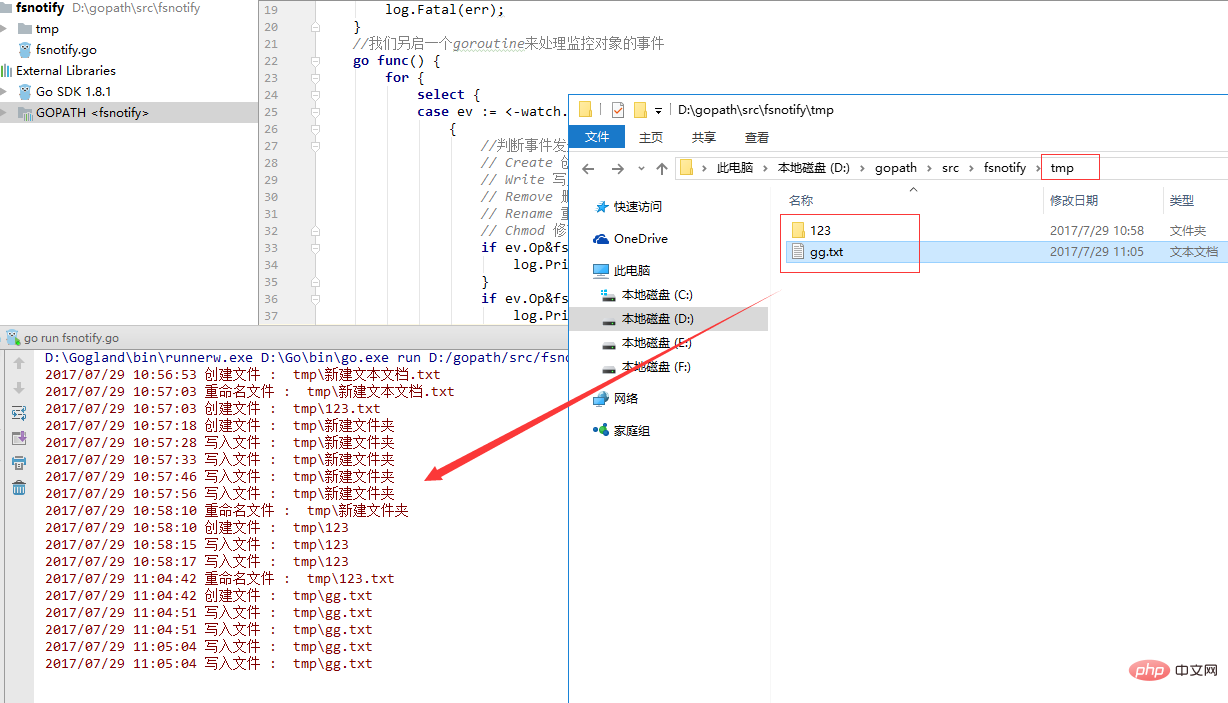Home >Backend Development >Golang >How to implement file monitoring in golang
How to implement file monitoring in golang
- 青灯夜游Original
- 2023-02-20 10:15:374909browse
In golang, you can use fsnotify to implement file monitoring. fsnotify is a cross-platform file system monitoring tool in the Go language, which implements a channel-based, cross-platform real-time monitoring interface; golang can monitor files through fsnotify and restart the program through file changes.

The operating environment of this tutorial: Windows 10 system, GO version 1.18, Dell G3 computer.
In golang, you can use fsnotify to implement file monitoring.
golang monitors files through fsnotify and restarts the program through file changes.
Go language cross-platform file system monitoring tool - fsnotify
In the Linux kernel, Inotify is a tool used to notify users Mechanism of spatial program file system changes. It monitors file system changes, such as file creation, modification, deletion, etc., and can notify applications of corresponding events.
Inotify can monitor both files and directories. When monitoring a directory, it can monitor the directory and each subdirectory and file in the directory at the same time. Golang's standard library syscall implements this mechanism.
In order to further expand and abstract, the github.com/fsnotify/fsnotify package implements a channel-based, cross-platform real-time monitoring interface.
Usage of fsnotify tool
1. Download the packages we need
go get github.com/fsnotify/fsnotify
2. Use fsnotify to monitor files
|
1 2 3 4 5 6 7 8 9 10 11 12 13 14 15 16 17 18 19 20 21 22 23 24 25 26 27 28 29 30 31 32 33 34 35 36 37 38 39 40 41 42 43 44 45 46 47 48 49 50 51 52 53 54 55 56 57 58 59 60 |
##package main ; import (
##
## , ev.Name); "Delete file: " } "Rename file: "
//Loop select {}; The test results are as follows:
All our operations in the tmp directory were captured, but there is a problem with fsnotify. It cannot help us capture subdirectories recursively. The operation events of the Sun Tzu directory need to be implemented by ourselves. Another problem is that when we modify the folder name, the event.Name in fsnotify is still the original file name. This requires us to first remove the previous monitoring in the rename event, and then add New monitoring. Modify as follows:
The test results are as follows: After the above example, we use fsnotify to write a monitoring configuration file. If the configuration file is modified, the service will be restarted. We first write an exe program that can be run. The server.go code is as follows:
|
The above is the detailed content of How to implement file monitoring in golang. For more information, please follow other related articles on the PHP Chinese website!
Related articles
See more- Share the preliminary use of ChatGPT (laravel and go examples)
- A brief analysis of nil and zero values in Golang
- GO goutil released version v0.6.4! Update at a glance!
- How does Go language determine whether a certain method exists in a structure? Two ways to introduce
- An article to talk about the resource competition problem in Go language
- What programming language is go language?



